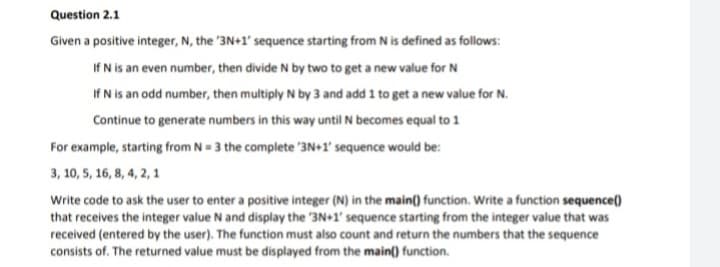Question 2.1 Given a positive integer, N, the '3N+1' sequence starting from N is defined as follows: If N is an even number, then divide N by two to get a new value for N If N is an odd number, then multiply N by 3 and add 1 to get a new value for N. Continue to generate numbers in this way until N becomes equal to 1 For example, starting from N = 3 the complete "3N+1' sequence would be: 3, 10, 5, 16, 8, 4, 2, 1 Write code to ask the user to enter a positive integer (N) in the main() function. Write a function sequence() that receives the integer value N and display the 3N+1' sequence starting from the integer value that was received (entered by the user). The function must also count and return the numbers that the sequence consists of. The returned value must be displayed from the main() function.
Question 2.1 Given a positive integer, N, the '3N+1' sequence starting from N is defined as follows: If N is an even number, then divide N by two to get a new value for N If N is an odd number, then multiply N by 3 and add 1 to get a new value for N. Continue to generate numbers in this way until N becomes equal to 1 For example, starting from N = 3 the complete "3N+1' sequence would be: 3, 10, 5, 16, 8, 4, 2, 1 Write code to ask the user to enter a positive integer (N) in the main() function. Write a function sequence() that receives the integer value N and display the 3N+1' sequence starting from the integer value that was received (entered by the user). The function must also count and return the numbers that the sequence consists of. The returned value must be displayed from the main() function.
Database System Concepts
7th Edition
ISBN:9780078022159
Author:Abraham Silberschatz Professor, Henry F. Korth, S. Sudarshan
Publisher:Abraham Silberschatz Professor, Henry F. Korth, S. Sudarshan
Chapter1: Introduction
Section: Chapter Questions
Problem 1PE
Related questions
Question

Transcribed Image Text:Question 2.1
Given a positive integer, N, the '3N+1' sequence starting from N is defined as follows:
If N is an even number, then divide N by two to get a new value for N
If N is an odd number, then multiply N by 3 and add 1 to get a new value for N.
Continue to generate numbers in this way until N becomes equal to 1
For example, starting from N = 3 the complete '3N+1' sequence would be:
3, 10, 5, 16, 8, 4, 2, 1
Write code to ask the user to enter a positive integer (N) in the main() function. Write a function sequence()
that receives the integer value N and display the 3N+1' sequence starting from the integer value that was
received (entered by the user). The function must also count and return the numbers that the sequence
consists of. The returned value must be displayed from the main() function.
Expert Solution
This question has been solved!
Explore an expertly crafted, step-by-step solution for a thorough understanding of key concepts.
This is a popular solution!
Trending now
This is a popular solution!
Step by step
Solved in 2 steps with 1 images

Knowledge Booster
Learn more about
Need a deep-dive on the concept behind this application? Look no further. Learn more about this topic, computer-science and related others by exploring similar questions and additional content below.Recommended textbooks for you

Database System Concepts
Computer Science
ISBN:
9780078022159
Author:
Abraham Silberschatz Professor, Henry F. Korth, S. Sudarshan
Publisher:
McGraw-Hill Education

Starting Out with Python (4th Edition)
Computer Science
ISBN:
9780134444321
Author:
Tony Gaddis
Publisher:
PEARSON

Digital Fundamentals (11th Edition)
Computer Science
ISBN:
9780132737968
Author:
Thomas L. Floyd
Publisher:
PEARSON

Database System Concepts
Computer Science
ISBN:
9780078022159
Author:
Abraham Silberschatz Professor, Henry F. Korth, S. Sudarshan
Publisher:
McGraw-Hill Education

Starting Out with Python (4th Edition)
Computer Science
ISBN:
9780134444321
Author:
Tony Gaddis
Publisher:
PEARSON

Digital Fundamentals (11th Edition)
Computer Science
ISBN:
9780132737968
Author:
Thomas L. Floyd
Publisher:
PEARSON

C How to Program (8th Edition)
Computer Science
ISBN:
9780133976892
Author:
Paul J. Deitel, Harvey Deitel
Publisher:
PEARSON

Database Systems: Design, Implementation, & Manag…
Computer Science
ISBN:
9781337627900
Author:
Carlos Coronel, Steven Morris
Publisher:
Cengage Learning

Programmable Logic Controllers
Computer Science
ISBN:
9780073373843
Author:
Frank D. Petruzella
Publisher:
McGraw-Hill Education